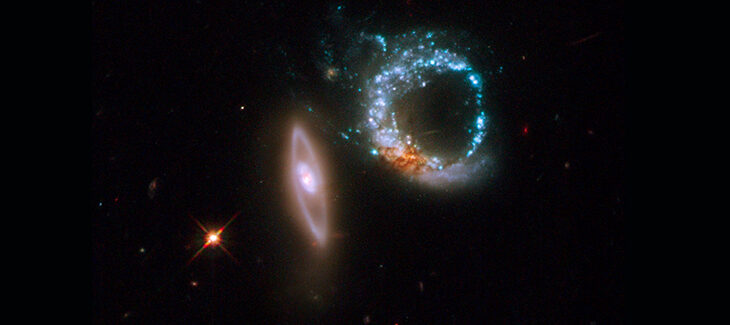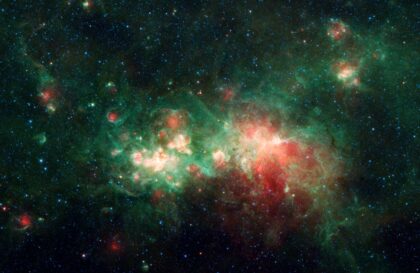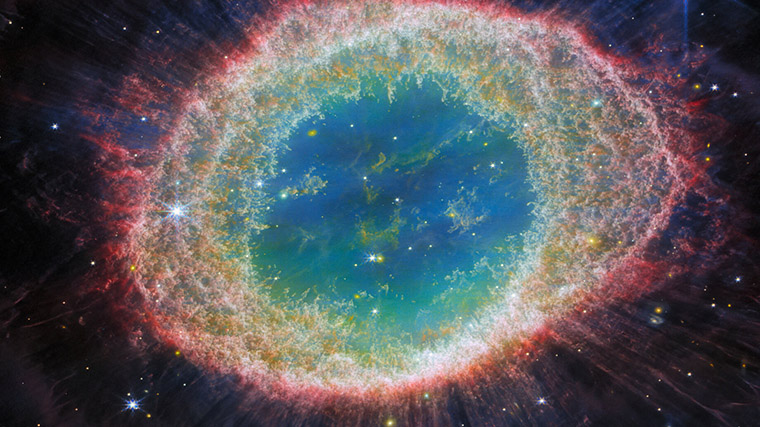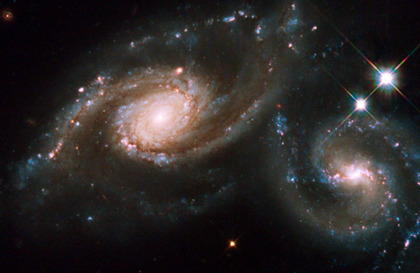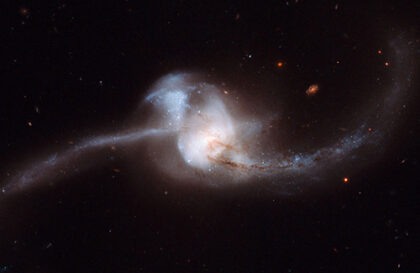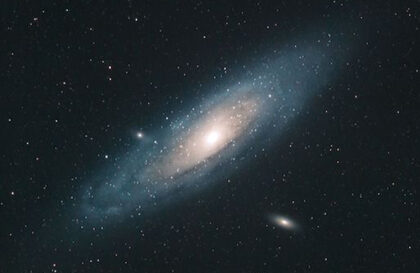Unique photo of the Hubble telescope
Just days after the orbiting observatory resumed operations, Hubble pointed its main camera, the Wide Field Planetary Camera 2 (WFPC2), at a remarkable object—a pair of gravitational interacting galaxies known as Arp 147.
The picture confirmed the excellent functioning of the camera, identical to the state before the temporary shutdown. This allowed her to earn the highest marks both for her work’s quality and aesthetics.
Indeed, the image received a “ten” for visual perception due to the unique location of the two galaxies. The galaxy on the left in the photo appears almost untouched, except for its exquisite ring of starlight, which we see from the side. The galaxy on the right is a bright blue ring where the process of new star formation is actively underway.
The blue ring was formed as a result of the left galaxy penetrating the right one. Similar to the circular waves created by a rock falling into a body of water, the collision of galaxies resulted in the formation of a wave of increased density that propagated outward. When this wave encountered external matter moving towards the center due to the gravitational interaction of galaxies, it led to compression and clumps of gas, causing active star formation.
A dusty red patch is visible in the lower-left corner of the blue ring, which likely indicates the original galactic core that was impacted. The main ring contains nine brightly glowing sources of X-ray radiation – black holes, each 10-20 times the mass of the Sun.
The right galaxy measures 30,000 light-years in size and is 21,000 light-years away from its companion. The total length of this system reaches approximately 115,000 light years.
Arp 147 is included in the Catalog of Unusual Galaxies, created by Halton Arp in the 1960s and released in 1966. This image is compiled from data obtained using three filters on the WFPC2 camera. Blue, green, and red hues represent blue, visible, and infrared light, respectively.
This space object was detected on October 27-28, 2008. Arp 147 is located in the constellation Cetus and is more than 400 million light years away from Earth.
The Hubble Space Telescope moves slowly away from Discovery following its release. The photo was taken during Servicing Mission 2 in 1997.
Arp 147. Something similar could happen between Andromeda and the Milky Way
The galaxy collision in Arp 147 may illustrate what is expected in a proposed collision between Andromeda and the Milky Way. However, it is worth considering a few nuances:
Size and structure: Andromeda and the Milky Way are two large spiral galaxies. Although Arp 147 is a galactic collision, these galaxies may have different characteristics than Andromeda and the Milky Way.
Collision Dynamics: Each collision is unique and depends on many factors, such as the initial position, speed, and angle of collision of the galaxies. So, while the overall characteristics of a crash may be similar, the details and final outcome may vary.
Duration of the process: The collision of Andromeda and the Milky Way is expected to take billions of years. Both galaxies will undergo significant changes in their structure and dynamics during this time. The Arp 147 collision lasted about 40 million years.
Outcome of the collision: According to some forecasts, the collision of Andromeda and the Milky Way will result in the formation of one elliptical galaxy. In Arp 147, one galaxy passed through another. The ring-shaped galaxy continues to expand. But we have yet to find the result.
Evolution after collision
An interesting point is how the collision of galaxies can influence their further evolution. When galaxies collide, their mutual gravitational attraction can cause significant changes in their structure and dynamics. This can lead to increased star formation, as seen in the blue ring in the Arp 147 galaxy.
Such collisions could also contribute to forming new galactic nuclei or even central black holes. Studying systems like Arp 147 provides a unique opportunity to learn processes that may have occurred in the early Universe when galaxy collisions were more frequent.
In addition, studying such galaxies can help scientists better understand how galactic collisions affect the formation and growth of black holes at the centers of galaxies and the distribution of dark matter in galaxies.
Ultimately, galaxies like Arp 147 symbolize the constant evolution of astronomical objects in the Universe over time.
Banner image: Unusual duo: Arp 147 is an interesting pair of interacting galaxies. The left one seems undisturbed, while the galaxy on the right has been shaped into a ring and is experiencing vigorous star formation. Credit: NASA, ESA and M. Livio (STScI)
Image credit:
https://www.esa.int
